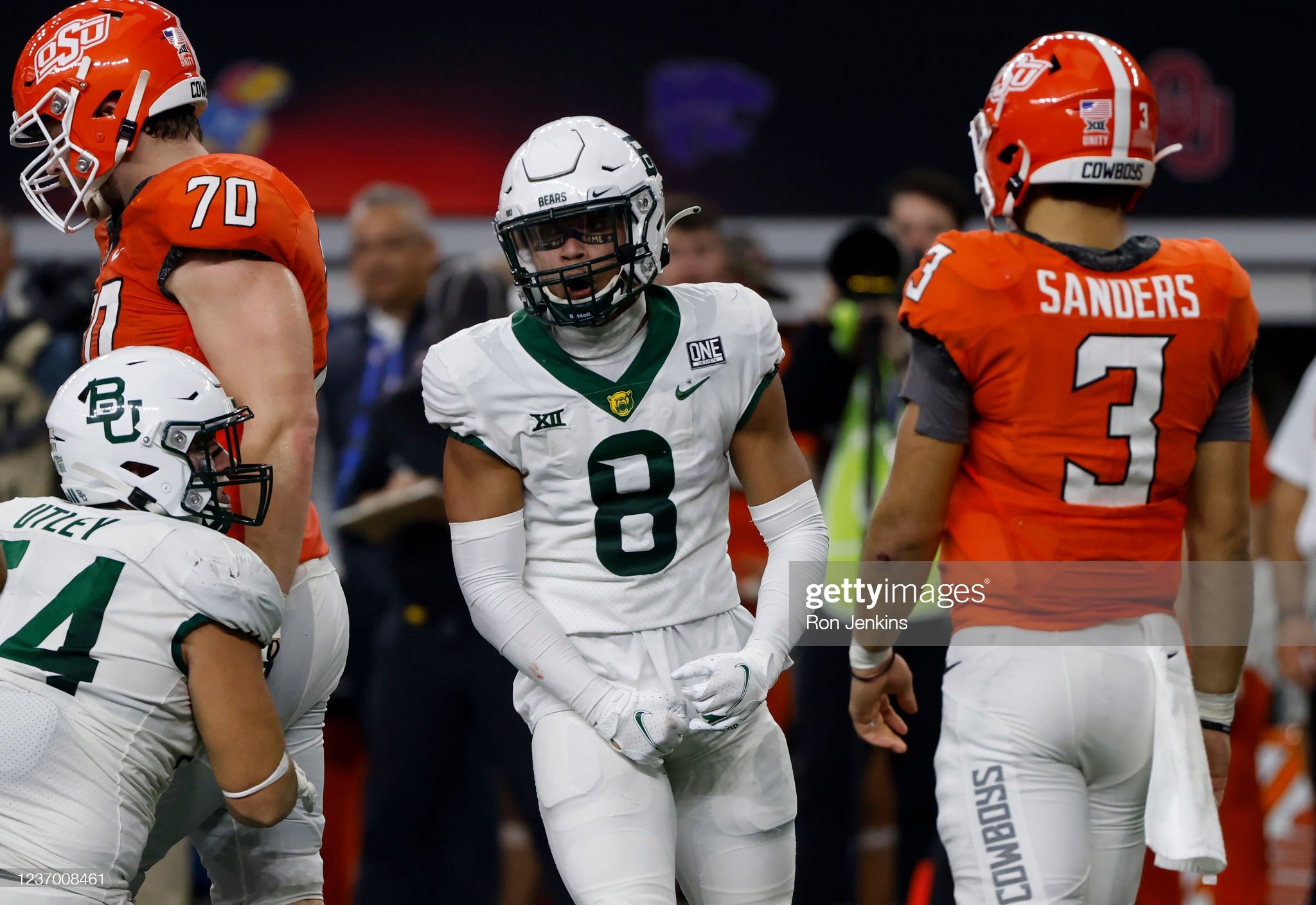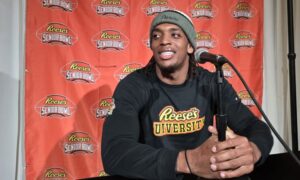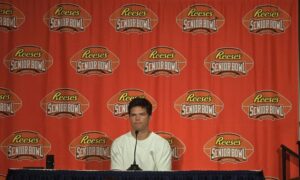From now until the 2022 NFL Draft takes place, we hope to scout and create profiles for as many prospects as possible, examining their strengths, weaknesses, and what they can bring to an NFL franchise. These players could be potential top 10 picks, all the way down to Day 3 selections and priority undrafted free agents. Today, I’m profiling a player who used the 2022 Senior Bowl to launch himself onto everybody’s radar, and who would provide any team in the NFL a physical and gritty presence along the back line of a defense.
#8 Jalen Pitre, S, Baylor (R-Sr.) — 5110, 198 lbs.
Measurements
Senior Bowl
| Player | Ht/Wt | Hand Size | Arm Length | Wingspan |
|---|---|---|---|---|
| Jalen Pitre | 5110/198 | 9″ | 30 5/8″ | 73 1/2″ |
| 40-Yard Dash | 10-Yard Dash | Short Shuttle | 3-Cone | |
| N/A | N/A | 4.18 | 6.74 | |
| Broad Jump | Vertical | Bench Press | ||
| N/A | 35 | 16 |
The Good
— Physical player in coverage. Loves to chip players as they enter his zone, and try to knock them off their route in man.
— Excels working downfield from deeper zone coverage, constantly reading what’s below him and staying aware of QB’s eyes.
— Quick to break downhill in zone to contest throws below him, or to blow up screen plays.
— Handles off-man coverage, stays in position to deny throws to out routes, and picks up RBs leaking out to flat.
— Sure tackler when he makes good contact. Able to deliver occasional hard pops up high, does not let runners slip when he gets them around legs.
— Makes a quick break to crash downhill against the run or on throws below his zone.
— Quickly accelerates to top speed when being sent off the edge, able to pressure or force QBs from pocket, contact runners before they reach line.
— Keeps himself in position as backside defender to deny bounce-back runs, counters, or option plays.
— Shifty enough to dodge blocks when attacking off the edge against the run.
— Frequent communicator pre-snap with good play recognition and awareness, helps key teammates in on adjustments.
The Bad
— Doesn’t have quick enough change of direction to stick with all possible assignments.
— Not as aware in zone coverage of deeper routes and players moving behind him, doesn’t disrupt throws as frequently as he does working downhill.
— Playing tight man off the line, doesn’t react quick enough to cuts or swim moves inside, unable to catch back up to deny pass.
— Too reliant on going low to make tackles instead of using his strong tackling up high, aware players can evade.
— Struggles staying in front of players employing juke move in open field when coming downhill from deep.
— When coming deep downhill, will build too much speed and overrun the ball carrier.
Bio
— Started his freshman, redshirt junior, and redshirt senior seasons for Baylor, finishing with 32 career starts in 52 games played.
— Shoulder injury limited him to four games in 2019 (junior season). Came back to start all 23 of Baylor’s games final two seasons.
— 2021 Big 12 Defensive Player of the Year, first DB to win in eight years. Honorable Mention for 2020 award.
— Two-time All-Big 12 First Team (2020, 2021), three-time Academic All-Big 12.
— 2021 Jim Thorpe Award finalist (best defensive back); 2021 Bednarik Award, Nagurski Trophy Watch Lists; 2021 Campbell Trophy semifinalist (Academic Heisman Trophy).
— 2021 Consensus All-American, primarily appearing on first teams.
— Career stats: 190 tackles (138 solo), 33.5 tackles for loss, seven sacks, 12 passes defensed, four interceptions, four forced fumbles, three fumbles recovered.
— 2021 stats: 70 tackles (54 solo), 14 tackles for loss, seven passes defensed, two interceptions, three forced fumbles, three fumble recoveries. Career-highs across the board, led Baylor in TFL, PD, FF, and FR.
— Had 60 tackles (41 solo), 13 tackles for loss, two interceptions, and a forced fumble in only nine games in shortened 2020 season.
— Began career as a linebacker, played strong- and weak-side first two seasons. Converted to hybrid defender role in 2020, led to breakout two seasons and All-Big 12 recognition.
— 3-star recruit, also received offer from SMU.
— Grew up three hours from Baylor.
— Pursuing Master’s degree in Educational Psychology.
Tape Breakdown
Among players attending the 2022 Reese’s Senior Bowl, one of the first ones to draw the attention of the draft community was Baylor’s Jalen Pitre. Playing a physical style of coverage in one-on-ones and in full 11-on-11 drills, Pitre quickly amassed pass break-ups and began what was an outstanding week that resulted in his being named the top safety on the National team at the event.
That week in Mobile elevated his draft stock and name recognition among the draft community, and continued building on an impactful career at Baylor, where he became a fan favorite and one of the more impactful defenders the Bears have had in recent seasons. The All-American shined with the Bears despite an injury his junior season and a coaching change halfway through his career there.
It was that coaching change, from Matt Rhule to Dave Aranda, where Pitre found his current role and what he projects to in the NFL. Playing for Aranda, Pitre switched from his spot at linebacker to playing a Star role, which saw him line up frequently in the slot for zone and off-man assignments, while also occasionally playing closer to the box and deeper as a safety. While playing in the slot, his primary alignment, Pitre would also be sent off the edge as a blitzer and against the run, or even as a looper inside.
Playing out in that slot role or deeper, Pitre showed an ability to make plays and limit gains while playing in zone and off-man coverage. Playing back from the line, Pitre surveys the entire field below him while also maintaining a focus on where the opposing quarterback was targeting. From there, he puts himself in position to erase throwing lanes when able, or make exceptionally quick breaks downhill to charge in and break up passes, or limit the gains when a catch could be made. Take, for example, this rep from his team’s game against BYU this season.
Pitre (lined up near the slot on the 40-yard line) initially drops back while lined up against BYU’s Neil Pau’u. He puts himself in a spot where he can defend Pau’u while also reading the quarterback’s eyes, and makes an immediate break past Pau’u when he sees a throw made to the shallow crossing route. Though the throw was off and not going to be caught anyway, Pitre accelerated and used his momentum to deliver a big hit that would have potentially forced an incompletion had the throw been more on-target.
Delivering big hits like that is something Pitre is capable of, but he doesn’t fill highlight reels with them like other head-hunting safeties. His physicality comes through more frequently in how he battles in coverage. Pitre will chip receivers as they run through his area in zone, and likes to do the same to try and knock the off their route early when in man coverage. When battling along routes, he stays engaged and will hand-fight throughout, especially when he senses or reads that a throw is on the way.
Take for example this Senior Bowl one-on-one with Nevada’s Romeo Doubs. Pitre fires his hands at Doubs quickly off the line as Doubs tries to set up a move toward the back corner of the end zone. As he reads that a throw is coming, Pitre begins hand-fighting with Doubs, and gets an arm up to deny a catch just as the ball arrives, timing it well despite not being able to turn and look for it at any point.
Pitre’s vision and ability to read the field— as he does on that rep by reading Doubs to know where the ball is in its flight — is something that helps him affect plays in coverage, as does his skill at reading a quarterback as a play progresses. The above two examples are in man, but many of Pitre’s highlights from the season came in zone, something he was used much more in at the Star spot in Baylor’s defense.
One of the biggest plays of the season for the Bears came from Pitre reading a QB on the fly, and putting himself just in the right position to make a play.
In the Big 12 Championship Game between Baylor and Oklahoma State, the Cowboys were at the one yard line with two attempts to score, likely win the title, and potentially jump into the final spot in the College Football Playoffs. Pitre, the furthest-right player on the back row of Baylor’s defense, reads pass and strafes to his left as Oklahoma State’s Spencer Sanders rolls out right. Following Sanders’ eyes, Pitre sees him lock in on Austin Jarrard, and senses Jarrard behind him to his right. Pitre cuts back in time, and breaks up the play to save Baylor’s lead. The Bears got a stop on the next play as well, winning the Big 12 title.
That’s easily the most high-stakes example of Pitre’s skill at reading quarterbacks, but not his only one. He does the same thing playing closer to the line in zone, including at the Senior Bowl in team drills.
Pitre is lined up on the right edge of the screen. As Cincinnati’s Desmond Ridder rolls out left, Pitre is with him every step of the way, watching where he is focused. When Ridder releases the throw, it is an easy play for Pitre to react and bat the ball away for an incompletion.
Pitre was frequently used near the line of scrimmage, not just to make plays like that. He also was tasked with picking up running backs who leaked out into the flat, or playing off-man and defending shorter routes. Another main usage of his near the line is something that separates him from how a lot of other DBs in this class were used.
Playing the Star for Baylor, Pitre was frequently sent off the edge of the offensive line while playing closer to the slot, or sent in up the middle on occasion on reps he was lined up closer to the box. Those situations were against both the run and the pass, and were a big part of how he picked up an incredible amount of tackles for loss for a defensive back. One of Pitre’s best athletic traits is his acceleration, which he used to launch off the line and often meet running backs in the backfield before they could hit a lane, or to force a quarterback from the pocket before routes could develop for him.
The first of those two plays showed Pitre’s work off the edge against the run. Lined up on the left edge of the screen, he reached top speed quickly as he got to the backfield and made a tackle at the line, chasing BYU’s Tyler Allgeier down just as he reached the lane his line had created, and limiting Allgeier’s gain. The second play came against Oklahoma on a passing down, when Pitre again came off the edge, dodging a pair of blocks to force Spencer Rattler to check it down to Jadon Haselwood, only getting back to the line when the play appeared design for a more aggressive throw downfield.
For a player of his size, Pitre does a solid job dodging blocks to apply pressure or get into the backfield when sent from the edge, and will also stay on the backside to deny any late counters or a lane for the runner to reverse field, and when he makes solid contact with a player, Pitre is a dependable tackler who can be relied on to make stops.
One of the criticisms watching Pitre’s tape is that, for as good a tackler as he is when he makes solid contact, he doesn’t always let himself get that contact on opponents. When he hits up high and gets his body into a tackle, the results are excellent, like on this play against Oklahoma, where he plants Kennedy Brooks to finish a play.
But he doesn’t choose to go high often enough with how skilled he is at making tackles in that way. Too often, Pitre chooses to go low to make tackles. And again, sometimes that is the only play to make and leads to excellent tackles, like this one on BYU tight end Rex Isaac.
But on some attempts, particularly working downhill with some speed, Pitre choosing to go low doesn’t allow him to make good enough contact to hang on and finish off a play, or get help to finish it off. Going downhill with some speed built up, he also can’t always stay in front of runners, and will get eluded or forced into a lunging arm tackle by runners who throw a juke, accelerate laterally or who throw on the brakes as he is arriving to olé him, like this attempt against Oklahoma State’s Sanders in their regular-season meeting, and then again against the Cowboys’ Jaden Bray in the Big 12 Championship.
The Senior Bowl helped Pitre elevate his draft stock, but did not come without some drawbacks. Mainly, in one-on-one drills where Pitre was asked to play tight man coverage off the line, something he did on a more limited basis in Baylor’s defense, Pitre had trouble sticking with receivers who had room to improvise and get free, moreso than in the above example vs. Doubs. He did win some of his reps and showed there is potential to improve in that area, but there were reps that looked like this, first against Cincinnati’s Alec Pierce and then against Rutgers’ Bo Melton.
On both reps, as quick as Pitre is, he can’t match the change of direction from the two receivers. Each sets up an inside cut and executes it to gain space on Pitre, Pierce firing his right hand out for leverage and cutting in on the slant and Melton getting Pitre twice, first beating him on a cut upfield, then using that edge to set up a cut inside and leaving Pitre grabbing. As a safety Pitre likely won’t be asked to play many downs like this, but it is an area that could stand to improve as he makes the jump to the NFL.
Conclusion
Jalen Pitre played a unique role for Baylor’s defense, and was one of the program’s top contributors on defense from the last several seasons. Carrying that momentum through to the Senior Bowl, he played very well there, rightfully being named one of the event’s biggest beneficiaries and showing that he can be a valuable contributor to an NFL defense on any team in the league.
The question for Pitre is going to be in what kind of role he can be used at in the league. He has room to improve in a lot of areas, and is most NFL-ready to take the field in a role similar to his Star spot in Baylor, playing primarily zone assignments and winning with his physicality playing near the intermediate level above the slot. Whatever team drafts him should embrace the versatility he developed with the Bears, and use him in several different spots within its defense based on the situation and how he matches up with the opposing team’s skill players. As that Star-esque defender, Pitre is ready to take the field within the first few weeks of his rookie season, playing a good percentage of his team’s snaps, but needs a little more development to take on a more traditional safety role as a team’s starter. The ceiling is there to grow into that role, and he could be a team’s starter by the last few weeks of his rookie year, or more likely as he enters his second season.
Projection: Mid-Day 2 (Later Round 2 to Early/Mid Round 3)
Depot Draft Grade: 8.1 (Future Quality Starter)
Games Watched: 2021: at Oklahoma State (regular season), vs. BYU, vs. Oklahoma, vs. Oklahoma State (Big 12 Championship), Senior Bowl practices








